1997 BUICK PARK AVENUE height
[x] Cancel search: heightPage 19 of 420
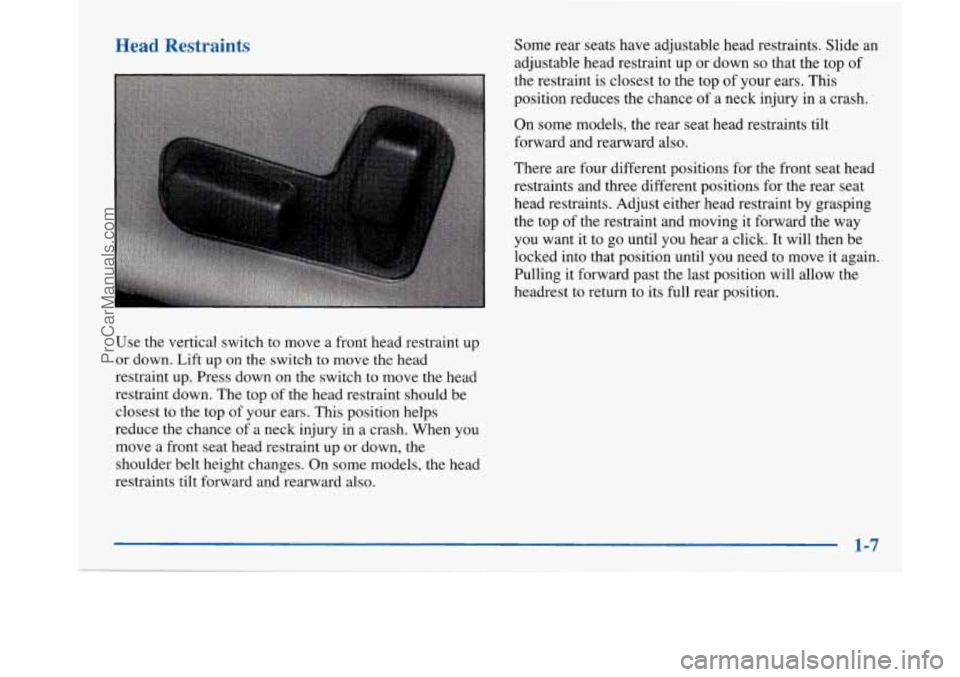
Head Restraints
Use the vertical switch to move a front head restraint up
or down. Lift up on the switch to move the head
restraint up. Press down on the switch to move the head
restraint down. The top of the head restraint should be
closest
to the top of your ears. This position helps
reduce the chance of a neck injury in a crash. When you
move a front seat head restraint up or down, the
shoulder belt height changes. On some models, the head
restraints tilt forward and rearward also. Some
rear seats have adjustable head restraints. Slide an
adjustable head restraint up or down
so that the top of
the restraint is closest to the top of your ears. This
position reduces the chance of a neck injury in a crash.
On some models, the rear seat head restraints tilt
forward and rearward also.
There are four different positions for the front seat head
restraints and three different positions for the rear seat
head restraints. Adjust either head restraint by grasping
the top of the restraint and moving it forward the way
you want it to go until you hear a click. It will then be
locked into that position until you need to move it again.
Pulling it forward past the last position will allow the
headrest to return to its full rear position.
ProCarManuals.com
Page 27 of 420
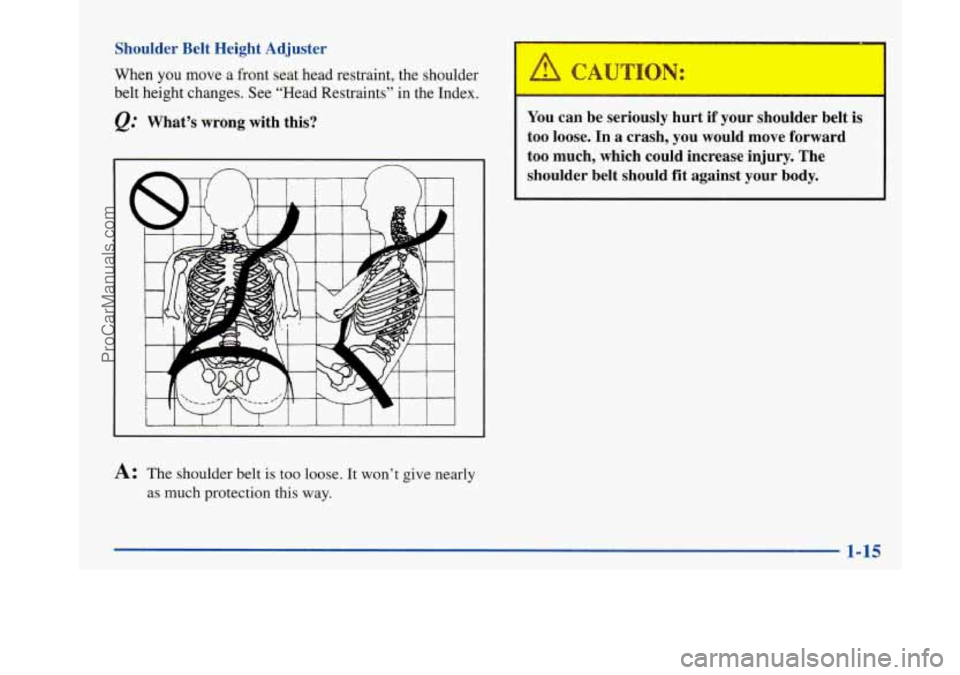
Shoulder Belt Height Adjuster
When you move a front seat head restraint, the shoulder
belt height changes. See “Head Restraints” in the Index.
@ What’s wrong with this?
A: The shoulder belt is too loose. It won’t give nearly
as
much protection this way.
You can be seriously hurt if your shoulc r belt is
too loose. In a crash, you would move forward
too much, which could increase injury. The
shoulder belt should fit against your body.
ProCarManuals.com
Page 116 of 420
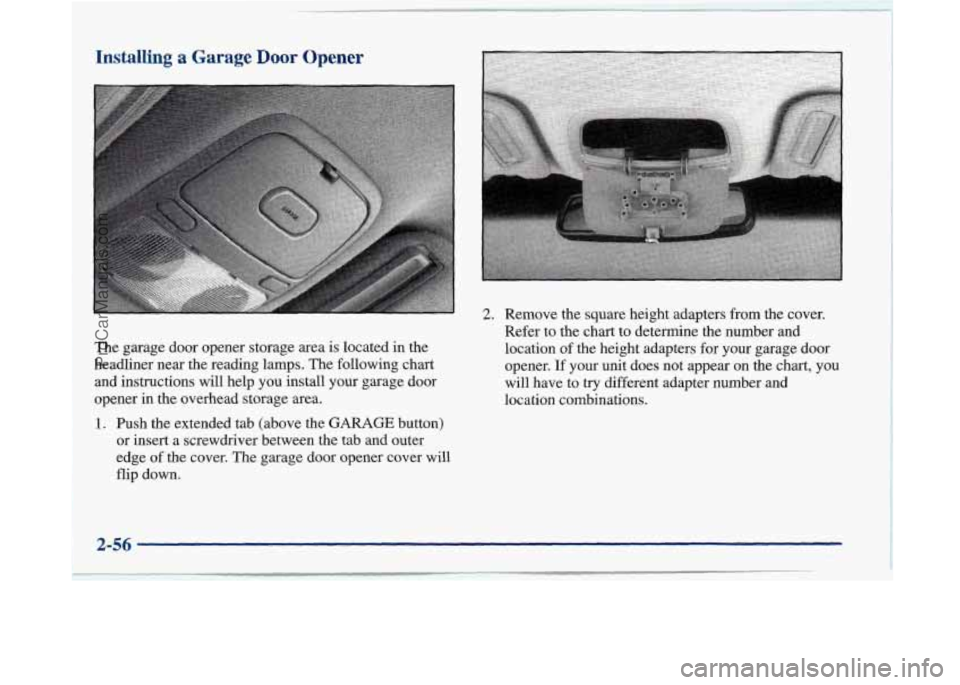
Installing a Garage Door Opener
The garage door opener storage area is located in the
headliner near the reading lamps. The following chart
and instructions will help you install your garage door
opener
in the overhead storage area.
1. Push the extended tab (above the GARAGE button)
or insert a screwdriver between the tab and outer
edge
of the cover. The garage door opener cover will
flip down.
2. Remove the square height adapters from the cover.
Refer to the
chart to determine the number and
location of the height adapters for your garage door
opener. If
your unit does not appear on the chart, you
will have to
try different adapter number and
location combinations.
2-56
ProCarManuals.com
Page 119 of 420
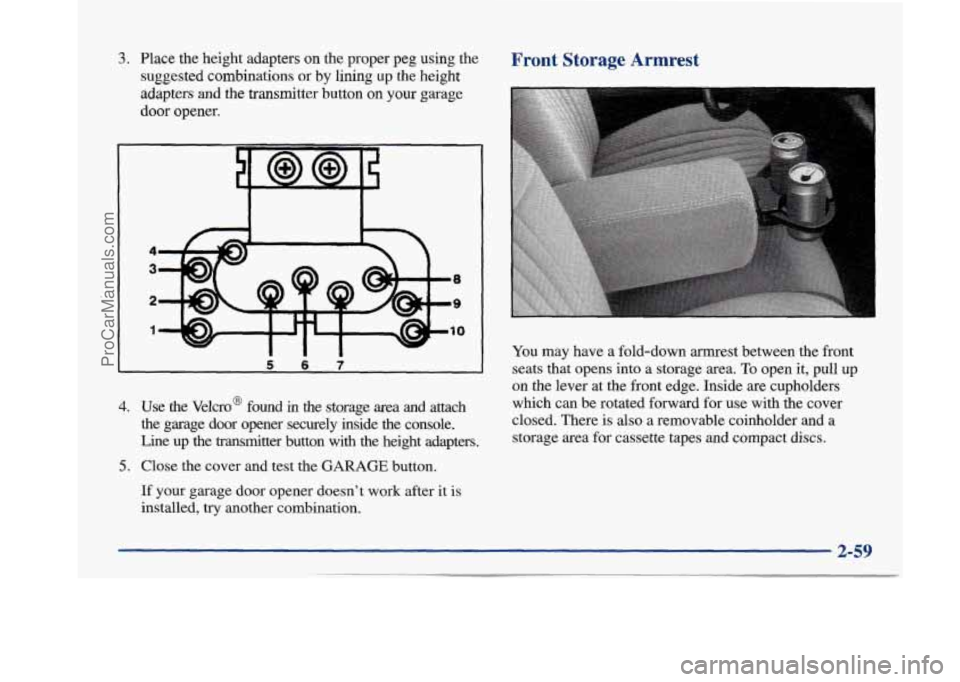
3. Place the height adapters on the proper peg using the
suggested combinations
or by lining up the height
adapters
and the transmitter button on your garage
door opener.
4
3
2
1
W Ill
4. Use the Velcro@ found in the storage area and attach
the garage door opener securely inside the console.
Line up the transmitter button with the height adapters.
5. Close the cover and test the GARAGE button.
If your garage door opener doesn’t work after it is
installed, try another combination.
Front Storage Armrest
You may have a fold-down armrest between the front
seats that opens into a storage area. To open it, pull up
on the lever at the front edge. Inside are cupholders
which can be rotated forward for use with the cover
closed. There is
also a removable coinholder and a
storage area for cassette tapes and compact discs.
2-59
ProCarManuals.com
Page 143 of 420
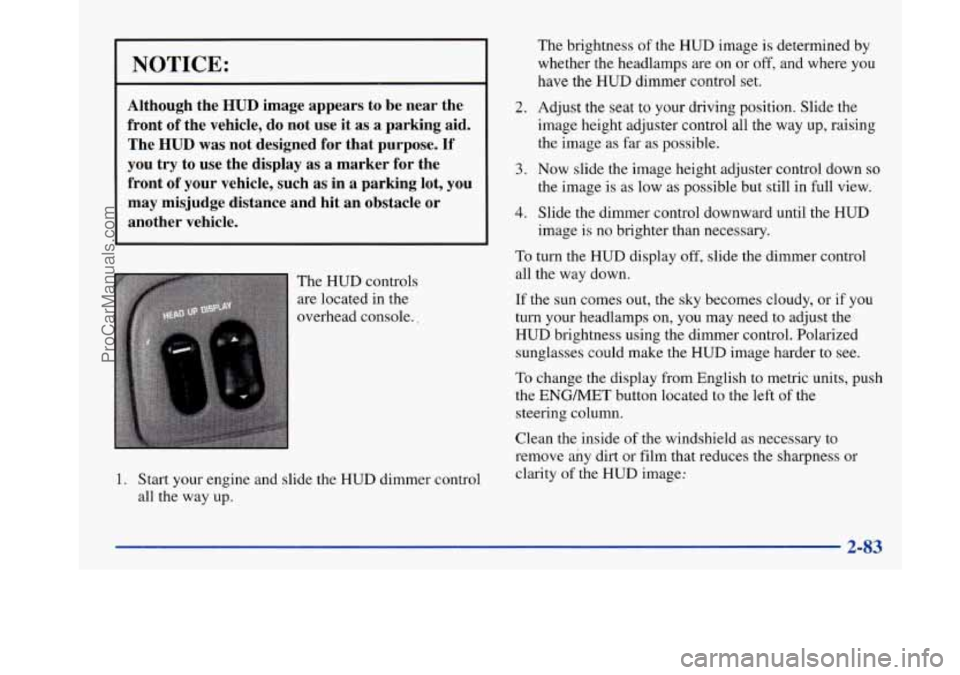
I NOTICE:
Although the HUD image appears to be near the
front
of the vehicle, do not use it as a parking aid.
The
HUD was not designed for that purpose. If
you try to use the display as a marker for the
front of your vehicle, such as in a parking
lot, you
may misjudge distance and hit an obstacle or
another vehicle.
The HUD controls
are located in the
overhead console..
1. Start your engine and slide the HUD dimmer control
all the way up.
2.
3.
4.
The brightness of the HUD image is determined by
whether the headlamps are on or
off, and where you
have the
HUD dimmer control set.
Adjust the seat
to your driving position. Slide the
image height adjuster control all the way
up, raising
the image
as far as possible.
Now slide the image height adjuster control down so
the image is as low as possible but still in full view.
Slide the dimmer control downward until the HUD
image is no brighter than necessary.
To turn the HUD display off, slide the dimmer control
all the way down.
If the sun comes out, the sky becomes cloudy, or if you
turn your headlamps
on, you may need to adjust the
HUD brightness using the dimmer control. Polarized
sunglasses could make the HUD image harder to see.
To change the display from English to metric units, push
the ENGMET button located to the left of the
steering column.
Clean the inside of the windshield as necessary to
remove any dirt or film that reduces the sharpness or
clarity of the
HUD image:
2-83
ProCarManuals.com
Page 144 of 420

To clean the HUD lens, spray household glass cleaner
on a soft, clean cloth. Gently wipe
and dry the HUD
lens. Do not spray cleaner directly on the lens to avoid
cleaner leaking inside the unit.
If the ignition is on and you can’t see the HUD image,
check to see
if
The headlamps are on.
Something is covering the HUD unit.
The HUD dimmer control is adjusted properly.
The HUD image is adjusted to the proper height.
A fuse is blown. See “Fuses and Circuit Breakers” in
the Index.
Keep in mind that your windshield is part of the HUD
system. If you ever have to have your windshield
replaced, be sure to get one that is designed for HUD or
your HUD image may look blurred or out of focus.
Driver Information Center (DIC)
(If Equipped)
Your Park Avenue may be equipped with a Driver
Information Center (DIC). The DIC will display
information about how your vehicle is functioning,
as well as warning messages if a system problem
is detected. The
following buttons
are
on the DIC control panel
which
is located to the left
of the steering column:
ODOKRIP: Use this button to display your total and
trip miles.
FUEL INFO: Press this button to display fuel
information such as, fuel used, fuel range and fuel
economy.
GAGE INFO: Use this button to display oil pressure,
oil life, coolant temperature, tire pressure and battery
information.
RESET: This button, used along with other buttons,
will reset system functions.
ENGMET: Use this button to change the display
between English and metric units.
ProCarManuals.com
Page 297 of 420

Some driving conditions or climates may cause a brake
squeal when the brakes are first applied or lightly
applied. This does not mean something is wrong with
your brakes.
Properly torqued wheel nuts are necessary to help
prevent brake pulsation. When tires are rotated, inspect
brake pads for wear and evenly torque wheel nuts in the
proper sequence to GM specifications.
Your rear drum brakes don’t have wear indicators, but if
you ever hear a rear brake rubbing noise, have the rear
brake linings inspected.
Also, the rear brake drums should
be removed and inspected each time the tires
are removed
for rotation
or changing. When you have the front brakes
replaced, have the rear brakes inspected, too.
Brake linings should always be replaced as complete
axle sets.
See “Brake System Inspection’’ in Section
7 of this
manual under Part
C “Periodic Maintenance
Inspections”.
Brake Pedal Travel
See your dealer if the brake pedal does not return to
normal height, or if there is a rapid increase in pedal
travel. This could be a sign of brake trouble.
Brake Adjustment
Every time you apply the brakes, with or without the
vehicle moving, your brakes adjust for wear.
Replacing Brake System Parts
The braking system on a modern vehicle is complex. Its
many parts have to be of top quality and work well
together
if the vehicle is to have really good braking.
Your vehicle was designed and tested with top-quality
GM brake parts. When you replace parts of your braking
system
-- for example, when your brake linings wear
down and you have to have new ones put in
-- be sure
you get new approved GM replacement parts.
If you
don’t, your brakes may no longer work properly. For
example, if someone puts in brake linings that are wrong
for your vehicle, the balance between your front and
rear brakes can change
-- for the worse. The braking
performance you’ve come to expect can change in many
other ways if someone puts in the wrong replacement
brake parts.
6-33
ProCarManuals.com
Page 319 of 420
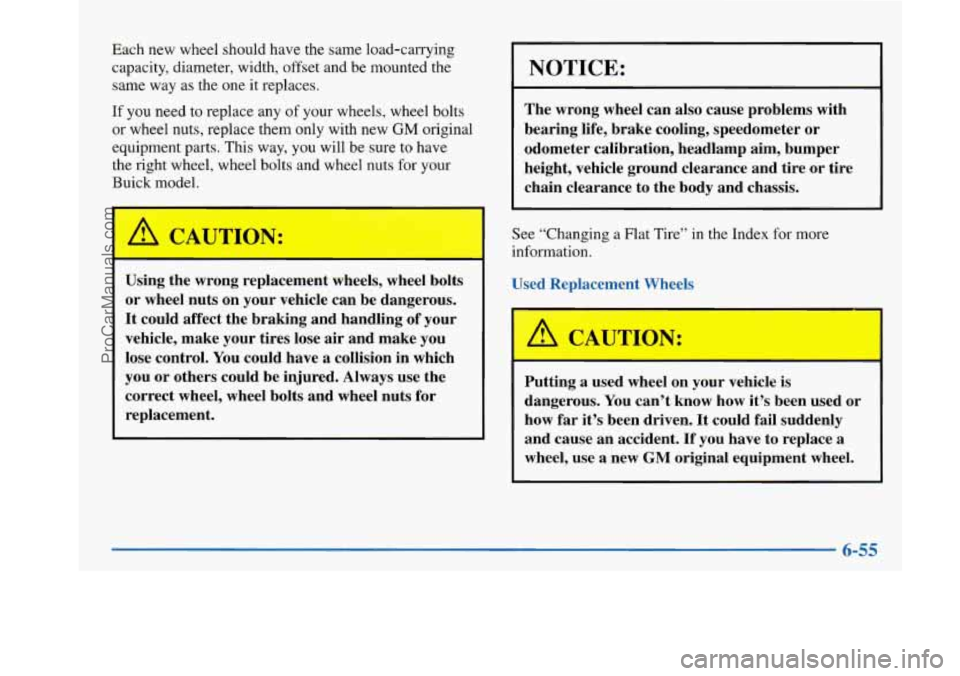
Each new wheel should have the same load-carrying
capacity, diameter, width, offset and be mounted the
same way as the one it replaces.
If you need to replace any of your wheels, wheel bolts
or wheel nuts, replace them only with new GM original
equipment
parts. This way, you will be sure to have
the right wheel, wheel bolts and wheel nuts for your
Buick model.
I
Using the wrong replacement wheels, wheel bolts
or wheel nuts on your vehicle can be dangerous.
It could affect the braking and handling of your
vehicle, make your tires lose air and make you
lose control. You could have
a collision in which
you or others could be injured. Always use the
correct wheel, wheel bolts and wheel nuts for
replacement.
NOTICE:
The wrong wheel can also cause problems with
bearing life, brake cooling, speedometer or
odometer calibration, headlamp aim, bumper
height, vehicle ground clearance and tire or tire
chain clearance to the body and chassis.
See “Changing a Flat Tire” in the Index for more
information.
Used Replacement Wheels
Putting a used wheel on your vehicle is
dangerous. You can’t know how it’s been used or
how far it’s been driven. It could fail suddenly
and cause an accident.
If you have to replace a
wheel, use a new
GM original equipment wheel.
ProCarManuals.com